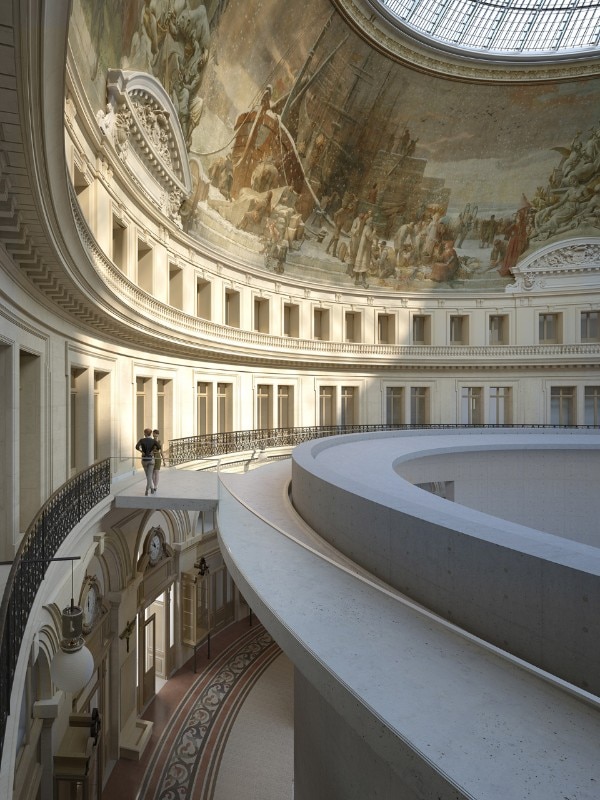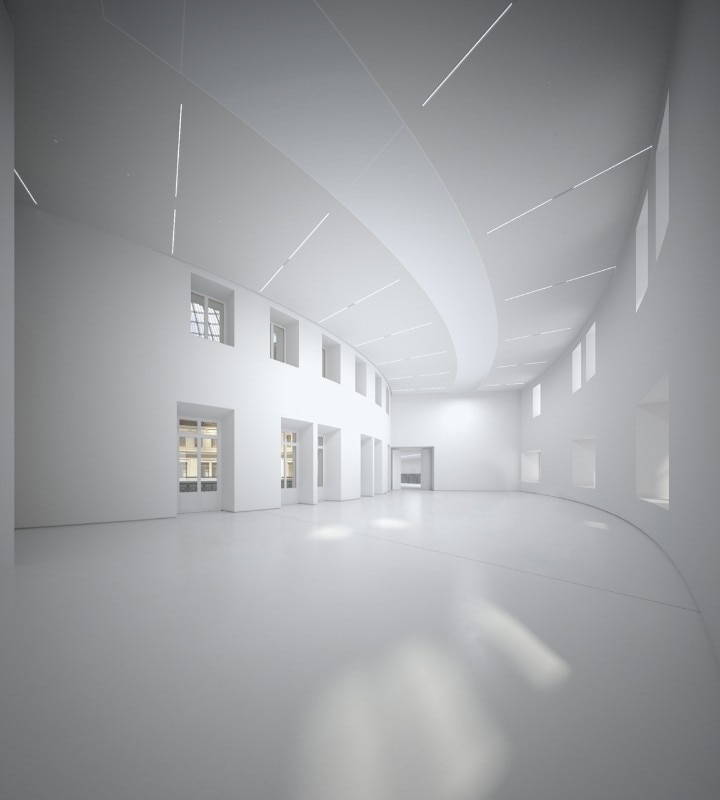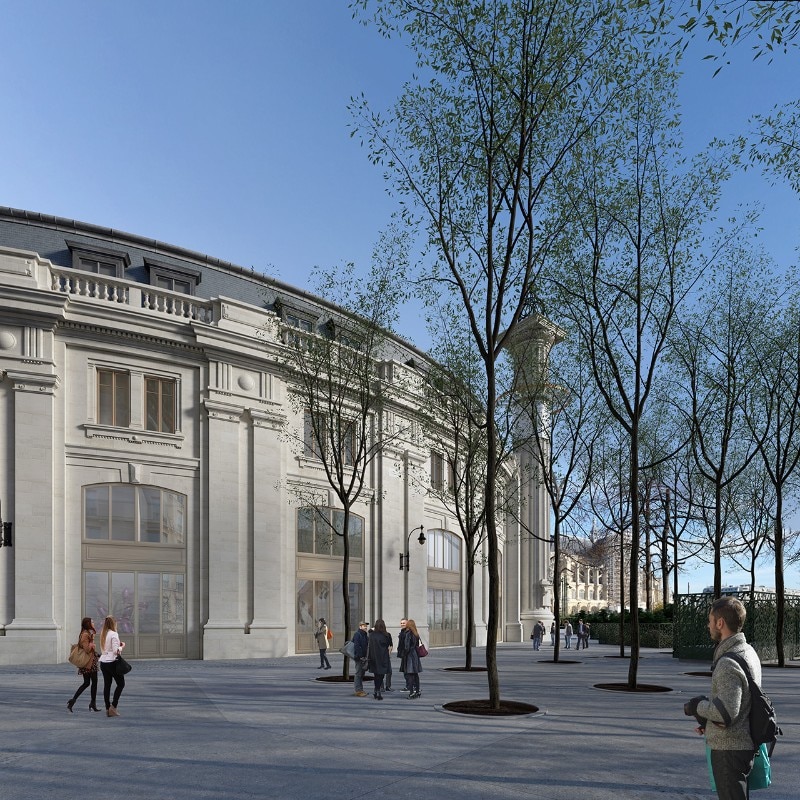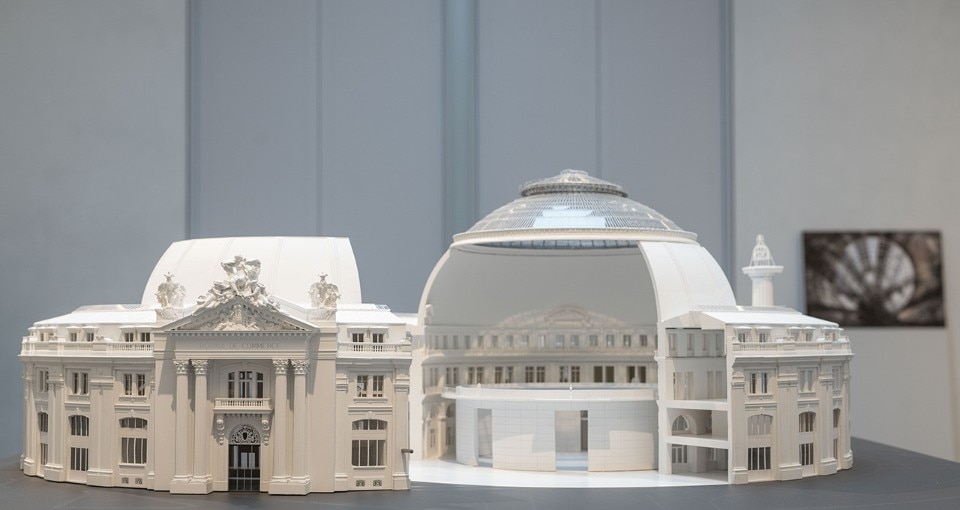With the new museum currently under construction in the heart of Paris, Tadao Ando once again takes on the challenge of the confrontation between past and present with a monument of great French historical importance, seeking to renew the building by creating a dialogue between heritage and innovation.
Its unique setting – in the center of the city between Les Halles and the Louvre, will undoubtedly be of great impact on Paris. Until now, the museum-related activity of the Pinault collection has taken place mainly in Palazzo Grassi and Punta della Dogana. Its new location in the Bourse de Commerce is confirmation of the desire of the collector to occupy historically important buildings. Martin Bethenod, the director of the Pinault Collection, explained how.

Three existing buildings fitted out by the same architect. What similarities emerged as a result of your interventions in the three sites?
The buildings all differ greatly, as do the architectural, urban, social and cultural contexts of Paris and Venice. On the contrary, the protagonists – the architect and the collector – are the same, as is the objective: to present contemporary art via the prism of the François Pinault collection. Above all, the spirit remains the same, and – as is the case with Palazzo Grassi and Punta della Dogana – lends the Bourse de Commerce a profound “sense of belonging”. This spirit is the result of an approach which is simultaneously radical, respectful and subtle, applied to a context of great importance from a point of view of both architecture and heritage.
The architecture of Tadao Ando seeks to create a dialogue with the setting. It is not so much a question of the object itself, the concrete cube which is the heart of Punta della Dogana or the cylinder which will be erected inside the Bourse de Commerce, but rather the relationship between these minimalist architectural objects and the surrounding environment. It is a gesture which Ando defines as a unifying element between the past and the present, between the abstract and the specific, between the architecture and the works of art.
What are the advantages and limitations presented by the existing building?
There are inevitably problems when working on a period building. The constraints – regarding for example accessibility, load on the ground, layout conditions – require constant research to identify solutions which would not be necessary in a building designed to be a contemporary art museum. But there are also many advantages. The first is that of setting the creation in a continuum without causing a break between past and present, thus maintaining a form of historical depth which serves as inspiration for the artists and an attraction for viewers. The second is the designing of unrepeatable spaces in an era marked by a tendency for standardisation. Showing a work at Punta della Dogana, where the history of the setting is dominant, is much more complicated. But when it functions works, it becomes unique and unforgettable. At the Bourse de Commerce, with its curved walls and numerous windows, the effect will be the same.

Did you encounter any complications relating to the laws protecting historical monuments in the two countries?
In both Venice and Paris, we had the great fortune of being able to work with very important figures. In Venice, the illuminating and constructive relationship between Tadao Ando and the superintendent Renata Codello allowed for the creation of the small miracles of Punta della Dogana and the Teatrino in Palazzo Grassi. In Paris, I am confident that the combined efforts of Tadao Ando’s architectural studios, of Thibault Marca and Lucia Niney, and of Pierre-Antoine Gatier will lead to the same effective, subtle and balanced result.
The building, which was constructed in 1763 to house the grain market, was radically remodelled in 1889 by Henri Blondel as a location for the Bourse de Commerce. The external façades contain the Medici columns, a 16th century monument which Caterina de’ Medici had ordered for the courtyard of her residence, as well as the cast iron dome which was rebuilt in 1813 by François-Joseph Bélanger following a fire. Pierre-Antoine Gatier, Architecte en Chef des Monuments Historiques responsible for the restoration of the Bourse de Commerce, spoke to us about the works.
Will the restoration lead the monument to a specific moment in its multi-faceted life?
1889 was an important moment, with the Universal Exposition and the Eiffel Tower, which symbolised the success of 19th century Rationalist construction. Posters from the period published on the occasion of the inauguration depicted both the Eiffel Tower and the Bourse de Commerce, which were considered important models of French technical ability. The symbolic value assumed by the dome justified the decision of Blondel, taken during the restoration of the pre-existing building, to conserve the 1813 framework, the largest in cast iron to be built in France. There are historical connections between the Eiffel Tower and the Bourse. Archive documentation shows that a number of firms worked on both monuments. Our project aims to restore it to its original state of 1889. It is therefore not a question of recovering a situation which had been lost and which is currently no longer visible, but of restoring the existing materials in a manner similar to Italian methods and which favours the conservation of all the historical stages of the monument.

Has it been easy to coordinate the restoration works with the intervention by the Ando studio?
A rapport of admiration and respect has been formed between the contemporary design team and our own team, a relationship characterised almost by a form of fascination for Ando, who draws much inspiration from the Pantheon of Rome. Thus, a form of intellectual continuity has emerged, which respects the existing circular form of the building. We were all there together, with the intention of inventing a complex structure which associated the reinforced concrete curtain and the period structure while at the same time ensuring reversibility. Tadao Ando’s cylinder plunges deep into the ground, and respectfully passes through Blondel’s floors, underlining the predominant desire to counter history with a “controlled” form of modernity. Further evidence of the positive rapport created on the work site can be found in the discovery of the wall coverings which decorated the ancient Salle des Pas Perdus and which depict scenes dedicated to commerce. The conservation project for these murals was immediately accepted by all those involved.
What are the criteria for choosing to renounce a historic element in favour of renewal?
The transformation towards a new function requires the building to be understood via a historical and archaeological analysis which allows for the distinguishing of the original structure from less exceptional interventions. This fundamental archaeological process must be well documented through constant comparison of architectural surveys and historical sources.


